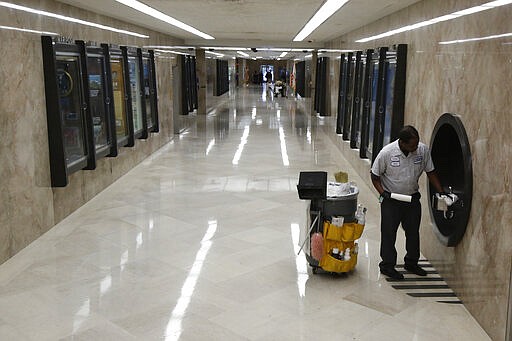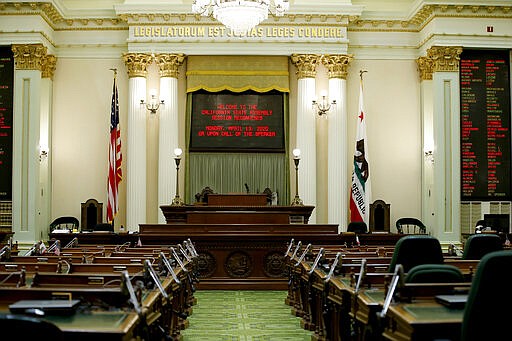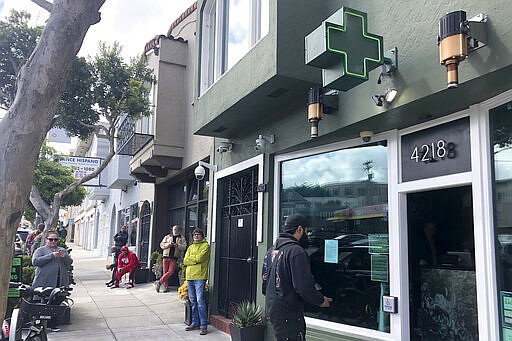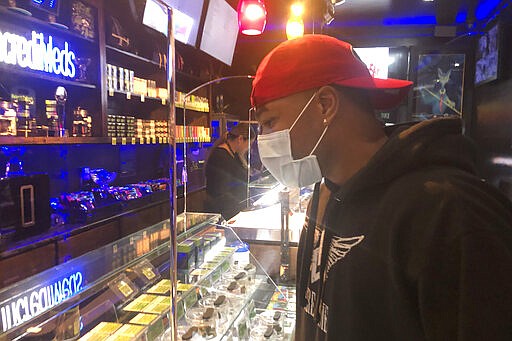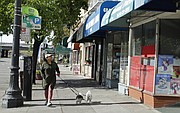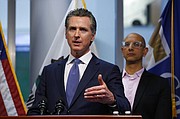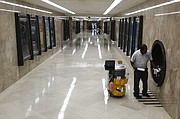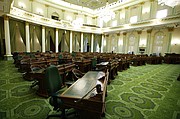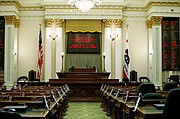More of California under tight restrictions due to virus
SACRAMENTO, Calif. (AP) — Extraordinary restrictions on everyday activities expanded to more areas of California on Wednesday as Gov. Gavin Newsom announced he would spend $150 million to try to head off the coronavirus from sweeping through the state's homeless population.
Two-thirds of the money will go directly to local governments to spend on homeless services and $50 million will be used by the state to purchase 1,300 travel trailers and lease hotel rooms for emergency housing.
California has more than 150,000 homeless people, the most in the nation, and there's concern that as the rest of the state's residents are being told to stay apart and to frequently wash their hands, the homeless are living just as they did before the outbreak. Newsom said it's possible 60,000 could contract the virus.
“I hope you get a sense of the seriousness we're taking the issue of homelessness,” he said in a Facebook Live broadcast.
The state will use the trailers for homeless people requiring isolation after testing positive for the virus or who are showing symptoms. It also has identified 950 hotels that could lease rooms to local governments to house the homeless.
The California Department of Public Health said Wednesday that the state now has 13 deaths related to the virus and more than 700 confirmed cases. More than 11,900 people are self-monitoring after returning from overseas.
Newsom has issued a series of emergency orders as the crisis spreads. Last week he urged all people over 65 and those with underlying health conditions to stay inside. He also limited the size of gatherings to 250 people and called for the shutdown of bars, movie theaters, fitness centers and other gathering places, and for restaurants to only serve to-go orders.
With virtually all of the state's children out of school because of closures, Newsom suspended standardized testing this spring. And with the economy shedding jobs he waived certain reporting requirements for businesses making mass layoffs.
Newsom said he will not issue a statewide lockdown on people's movements, preferring to allow local governments to make those decisions. And many have enacted tighter restrictions.
Napa and Solano on Wednesday joined at least 12 other Northern California counties — an area home to about 10 million people and including all of the San Francisco Bay Area — in requiring residents to stay home and go out only for essential purposes such as trips to grocery stores and to jobs in health care and other industries deemed critical.
In Southern California, the city of Palm Springs enacted similar restrictions. Los Angeles, San Diego and other major population centers in the region have not gone that far but have urged people to remain at home as much as possible.
Although Newsom hasn't ordered school closures, local authorities have done so. The governor said nearly 99% of the state's K-12 schools are shuttered.
Districts generally ordered closures between two and five weeks but Newsom said Tuesday it's likely most, and perhaps all, won't reopen before summer.
David De Leon, whose son is an 8th-grader in the Southern California city of Santa Ana, said he was shocked by the announcement, which would mean that so-called distance learning would be required for the rest of the school year.
“I don’t know if it’s viable,” De Leon said. “To throw it out for everyone to use until the end of the school year I think is unreasonable.”
In Los Angeles, Filiberto Gonzalez, 45, said his three children have been in touch daily with their teachers and have an hour to four hours per day of work they can do on an existing online platform that supplemented classes. But the prospect of moving to an entirely online system raises a slew of challenges few were expecting.
“This whole process started with ‘OK, we’re going to be away from school for two weeks, take this material with you, here’s a Chromebook,'” he said. “The news that came (Tuesday) was a real shock to a lot of us.”
For areas not sheltering in place, state and national parks remained an alternative to sitting on the couch, but with limitations.
California State Parks announced it is temporarily closing all its campgrounds and some small mountain towns dotting the Sierra Nevada range urged rock and mountain climbers to stay away. But trails and beaches remain open. Visitors were reminded to maintain social distancing.
Those who can't make it outside have an online alternative to enjoy California's coming spring.
In the tiny desert town of Borrego Springs, which draws throngs of tourists when rains bring a “super bloom" of wildflowers, residents are making videos and photographs of the evolving landscape and posting them on a web page called " Borrego Outside For People Inside."
"We hope it brings people a little bit of diversion, of happiness, a feeling of actually being here," said Mike McElhatton, program director of the Anza-Borrego Desert Natural History Association.
___
Associated Press journalists Amy Taxin in Santa Ana and Julie Watson in San Diego, contributed to this story. Antczak reporter from Los Angeles.






